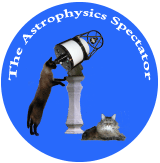
The basic layout of the site is as survey paths, which can be found under the Surveys link at the top of this and most other pages on this site. Each survey begins with a basic overview of the subject. Part of this overview include simulators of astrophysical phenomena that allow the reader to experiment with the phenomena. The later pages in a survey present the subject in greater and more mathematical depth. A path ends with research pages that describe current research projects and results in astrophysics.
The links at the top of each page are Home, which is the current home page of this site, Commentary, which is an index of short essays on topics loosely related to astrophysics, Surveys, which is the index of survey paths, Research, which is the index of research pages and the page leading to recent news items, Background, which is the index page for all background information on astrophysics, including survey pages, simulator pages, tables, bibliographic references, and lists of web resources, Previously, which is an index of previous home pages, and Site Info, which describes the site and its author, and gives contact information.
On the home page is found an addition link. This is the Store link, which leads to reviews of worthwhile books on astronomy and other relates subjects. Links on these pages enable the reader to buy these books from Amazon.com, which helps to financially sustain this web site.
Each Wednesday, a new issue of The Astrophysics Spectator is published that comprises a new home page, a new commentary, whatever news the author notices, and background, research, and simulator pages added to the survey paths. The home page acts as an index to the newly added pages. This site also has an RSS channel, whose link is given at the bottom of the right-hand column of this page.
March 16, 2005
I take a break from the stars and turn my attention to Uranus and Neptune this week. In a new page on the “Solar Planetary System” path, I discuss how the composition of Uranus and Neptune differ from their gaseous giant neighbors, Jupiter and Saturn.
Uranus and Neptune are ice giants, and their differences with Jupiter and Saturn tells us something about the processes that formed the planets in the Solar System. They are considerably smaller than either Jupiter or Saturn, and they are considerably farther from the Sun than either gaseous giant. These two characteristics makes these planets extremely cold. But more important is that their composition is very different from that of Jupiter and Saturn. The theories for the interiors of Uranus and Neptune have them primarily composed of water, ammonia, and methane ices surrounded by an atmosphere of hydrogen and helium. Their composition resembles the composition of objects in the Kuiper belt, the asteroid belt beyond the orbit of Neptune, and it resembles the composition of the moons of Jupiter and Saturn.
The current theory for the formation of these planets is that a belt of ice asteroids extended from inside the current orbit of Jupiter to the outer edge of the current Kuiper belt. Beyond the orbit of Saturn, the largest asteroids gradually consumed all of the small asteroids, until finally only two objects remained—Uranus and Neptune. Whether Jupiter and Saturn formed in a similar manner is a matter of debate.
This week I complete my rambling about academic freedom with a commentary on the role of academic freedom at the university.
I add another book review to the book store. I discuss the book of one of my favorite classical astronomers, On the Revolutions of Heavenly Spheres by Nicolaus Copernicus. The modern reader can acquire many insights on both historical and modern science from this book.
Jim Brainerd
Commentary
Academic Freedom and the University Professor. The rights and obligations of academic freedom should define the obligations of the university professor. Some tenured professors, however, refuse to live up to their obligations. The controversy over Ward Churchill at the University of Colorado is a stark example of this problem. Universities may need to put an end to tenure if they are to preserve their integrity. (continue)
Background
Giant Ice Planets. The two outer giant planets of our Solar System, Uranus and Neptune, differ significantly in compositions from the two inner giant planets, Jupiter and Saturn. Uranus and Neptune are no more than 15% hydrogen and helium by mass. These planets are predominately composed of water, methane, and ammonia ices, which is the reason they are referred to as giant ice planets. The composition of these planets is an important clue to how these planets formed. Current theory states that these planets formed by the gradual gravitational capture of numerous small ice asteroids. (continue)
Reviews
On the Revolutions of Heavenly Spheres. By Nicolaus Copernicus. We are so accustomed to a Sun-centric Solar System that we forget how difficult it was for Copernicus to demonstrate the superiority of his theory over the dominant Ptolomeic system On the Revolutions of Heavenly Spheres, the book in which Copernicus introduces his theory to the world, is a masterpiece of observational and theoretical science. The book contains insights on scientific thinking for both the student of history and the student of modern science. (continue)

RSS Channel
